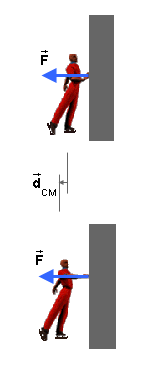where M is the mass of the system or object and V the speed of the CM of the system. For a definition of CM-Work, go to CM-Work under Related Items.
The CM-work theorem for a system, or for an object that may be deformable, is analogous to the work-kinetic energy theorem for a single particle. The differences are that the net work must be replaced by net CM-work and that the kinetic energy of the particle must be replaced by translational kinetic energy of the system or object. (CM stands for center of mass.)
CM-Work Theorem For A System
The theorem says that the CM-work WCM,net done by the net external force acting on a system or object is equal to the change in the translational kinetic energy of the system or object. In symbols,
WCM,net = Δ[M/2 V2]
(1)
where M is the mass of the system or object and V the speed of the CM of the system. For a definition of CM-Work, go to CM-Work under Related Items.
Comments
Example
Suppose a skater is pushing off a wall, as in the illustration
below, and that the wall exerts a constant force  on the skater where
the wall is in contact with the skater's hand.
on the skater where
the wall is in contact with the skater's hand.

The illustration shows the skater initially when the skater is
at rest and at a later instant when the skater's CM has
undergone the displacement  CM. The skater is in contact with the wall
throughout this displacement.
CM. The skater is in contact with the wall
throughout this displacement.
The CM-work done by the wall on the skater is equal to FdCM. By the CM-work theorem, assuming the skater glides with negligible friction so that there is no CM-work done on the skater by friction, FdCM is equal to the change in the skater's translational kinetic energy or, since the skater started from rest, equal to the skater's translational kinetic energy (M/2)V2 at the end of the displacement,
![]() FdCM =
(M/2)V2 .
FdCM =
(M/2)V2 . ![]() (2)
(2)
If one knows the magnitude dCM of the displacement of the skater's CM and knows the skater's speed V at the end of the displacement, one can use this equation to calculate the magnitude of the force exerted by the wall on the skater.
Comment. In contrast to the CM-work theorem, the work-kinetic energy theorem for systems or extended objects provides no useful information when applied to the skater. The reason is that it involves the work done by all forces, external and internal, and includes all forms of kinetic energy, not only the translational kinetic energy of the system. We have no information about either the work done by the internal forces nor the kinetic energies of the parts of the system or object relative to the CM.